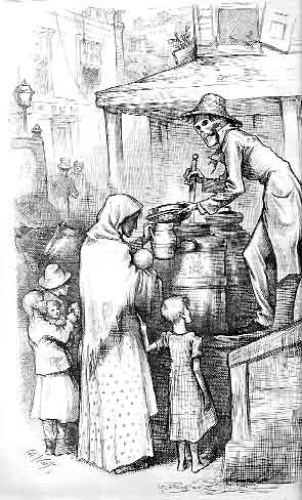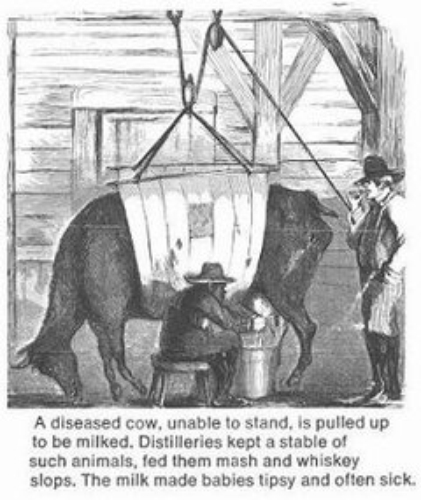Walkabout: The Great Milk Wars, Part 1
Read Part 2, Part 3, and Part 4 of this story. The longest war fought by New Yorkers in the 19th century was not the Civil War, which lasted a mere four years. It wasn’t the Spanish American War, either, which began in 1898. It was the Milk War, an ongoing conflict pitting business against…

Prospect Park Dairy
Read Part 2, Part 3, and Part 4 of this story.
The longest war fought by New Yorkers in the 19th century was not the Civil War, which lasted a mere four years. It wasn’t the Spanish American War, either, which began in 1898. It was the Milk War, an ongoing conflict pitting business against health, farmers against consumers, bottlers against unions, distributors against each other, and round and round. This war would continue, off and on, for almost a hundred years, and still sparks up even now. So, you milk your cows and send the milk to market, and get paid. What’s the big deal? Would that it were that easy. And it all begins with swill.
As Brooklyn and Manhattan expanded, it soon became apparent that farmers were not going to be able to house their livestock in our growing and bustling cities. Gone were the days when a farmer could keep his cows in the village green, and then deliver fresh milk to his customers. Pastures would have to be farther and farther into the rural areas surrounding our cities, and while the farmer had more land, he also had a big problem. This was the age before refrigeration and rapid transportation. The further away from a farmer’s marketplace, the greater the likelihood that the mild could spoil before delivery. The best container for unspoiled milk was the cow, so a plan was devised to deliver feed to city cows, making the field unnecessary. It would be a great concept in recycling, and would inextricably join two great needs in any Western city: the need for milk, and the need for liquor.
As early as the 1820’s and ‘30’s, farmers began buying the grain mash left over after whiskey distillers had processed liquor. Distilleries in the city went into the dairy business, and rented stalls to farmers, who would feed this mash to their cows. The mash had a higher caloric count than regular grass, and the cows produced more milk, but they got no exercise and were living in filthy conditions, which produced thin blue milk, soon known as “swill milk”. Milk wholesalers tried to doctor the milk by adding starch, plaster, chalk, or eggs to make it look thicker and whiter, which didn’t help its nutritional level, and added even more problems, and the potential for disease. Plaster? Swill milk was produced in other cities, but nowhere was it more prevalent than in New York City.
An immediate backlash occurred leading to a pure milk movement. By the late 1840’s, scientists were producing evidence showing that this stuff was dangerous to the health of children, leading to death before the age of five for literally half the children in the city, who were dying of tuberculosis, typhoid, or diarrhea-causing bacteria in swill milk. The press and prominent journalists got on board, documenting the deplorable state of the distillery “farms”, and the condition of the poor cows that suffered and died there, still being milked when they could no longer stand. Years later, in 1875, the city enforced a law that prohibited the sale of milk from distillery fed cows, and by the turn of the century, distillery dairies in Manhattan were history. But in 1904, a new health commissioner found that thousands of cows were still being fed distillery slop here in Brooklyn. The dairies set up in both Central and Prospect Parks were part of the movement to get fresh whole milk to city residents, and both had cows which were put to pasture in the park. The Prospect Park Dairy was torn down in the 1930’s, but Central Park’s Dairy was restored, and is now a visitor’s center.
Doctors and scientists began a movement towards “certified milk”, a term coined by Henry Coit, a scientist working in Newark, NJ, who had lost his own child due to contaminated milk. Teams of doctors would inspect the cows, their feed, their living conditions, their water, and the processes used to handle and transport the milk to market. This was a cumbersome and costly process, so the invention and implementation of pasteurization, as invented by Louis Pasteur in 1862, was a godsend to those desiring to improve the quality of milk. Pasteurization could take place in a factory setting, and be both practical and economical. It involved heating milk to kill the germs and bacteria, and then cooling the milk, all without cooking or spoiling it. But there was no way to force farmers to pasteurize, and the laws were still murky.
Like any new thing aimed at the public, the idea and process of pasteurization needed to be sold to the public. A campaign of awareness was needed, and it took the owner of the “world’s largest department store” to do it.” Here in New York City, Dr. Henry Koplik opened the world’s first dispensary to distribute pasteurized milk and teach mothers about infant hygiene in 1889. Nathan Straus, the owner of Macy’s, thought that this clinical method was not effective in reaching the tenements and masses of people throughout the city, so in June of 1893, he opened his first milk depot on the East 3rd Street Pier. It was a combination laboratory and recreation center, with a small pasteurizing and bottling plant next to a pavilion with tables and chairs. Mothers could come with their children and attend twice weekly lectures on child care and nutrition, refreshments were available, and doctors were on hand for free examinations. Both adults and children could see the milk being pasteurized and bottled, which was for sale at nominal prices.
The milk depot was a huge success, so much so that Straus opened six more the next year, and by 1906, had seventeen depots throughout the city. He had to have a centralized milk plant to meet the demand, but he knew he could never reach everyone who needed pasteurized milk, so he developed and sold the “Nathan Straus Home Pasteurizer”. Because of his efforts, many of the women in the tenements of the Lower East Side were pasteurizing milk before many of the local dairies were. The results were dramatic. Statistics showed the mortality rate among children dropping by half, just because of pasteurization. In 1895 Straus began a nationwide campaign, asking mayors around the nation to allow him to open his milk depots wherever he was invited. By the early 1900’s, depots based on his model were established in major cities, including in Brooklyn.
Society ladies took up the pure milk movement, establishing organizations such as the International Pure Milk League, with smaller “Mother’s Clubs”, where mothers were taught about nutrition and natural food preparation and hygiene. They were taught how to store and handle food safely, and pure pasteurized milk was dispensed at their meetings. The groups also lobbied to force dairies, milk wholesalers and retailers to abide by sanitation and preparation standards developed by the Department of Health. With their help, and with the backing of city law and vigorous inspection, New York City set the standard for the safest milk supply in the nation. By 1905, all milk traders had to be licensed, and all of their suppliers had to agree to inspections of their creameries and farms, no matter where those farms were.
So where was the war, you ask? The first battle in the Milk War was fought to end the practice of selling swill milk, and to combat contaminated milk. In 1883, however, there was another battle, this one much more familiar to those who follow any kind of economic trend. A battle broke out between the farmers who supplied the milk and the wholesalers and distributors who bought it, here in NYC. The farmers wanted more money for their milk, the distributors refused. Many farmers organized “spilling committees,” that blocked roads and spilled their own milk rather than sell to the distributors. This widespread protest led to a sharp decrease in the amount of milk that reached the city, forcing the distributors to pay the farmers a higher price. This would not be the last time this tactic was employed.
But the real war would be between the rival milk companies operating in the New York area in the 20th century. Brooklyn would be in the thick of things as Sheffield Farms, the Borden Condensed Milk Company, and the U.S. Dairy Products Company duked it out to become the kings of NYC milk. Our story continues next time.








Interesting history. Everything was so fraught in the old days wasn’t it? Swill milk, yuk. It is amazing we survived at all.